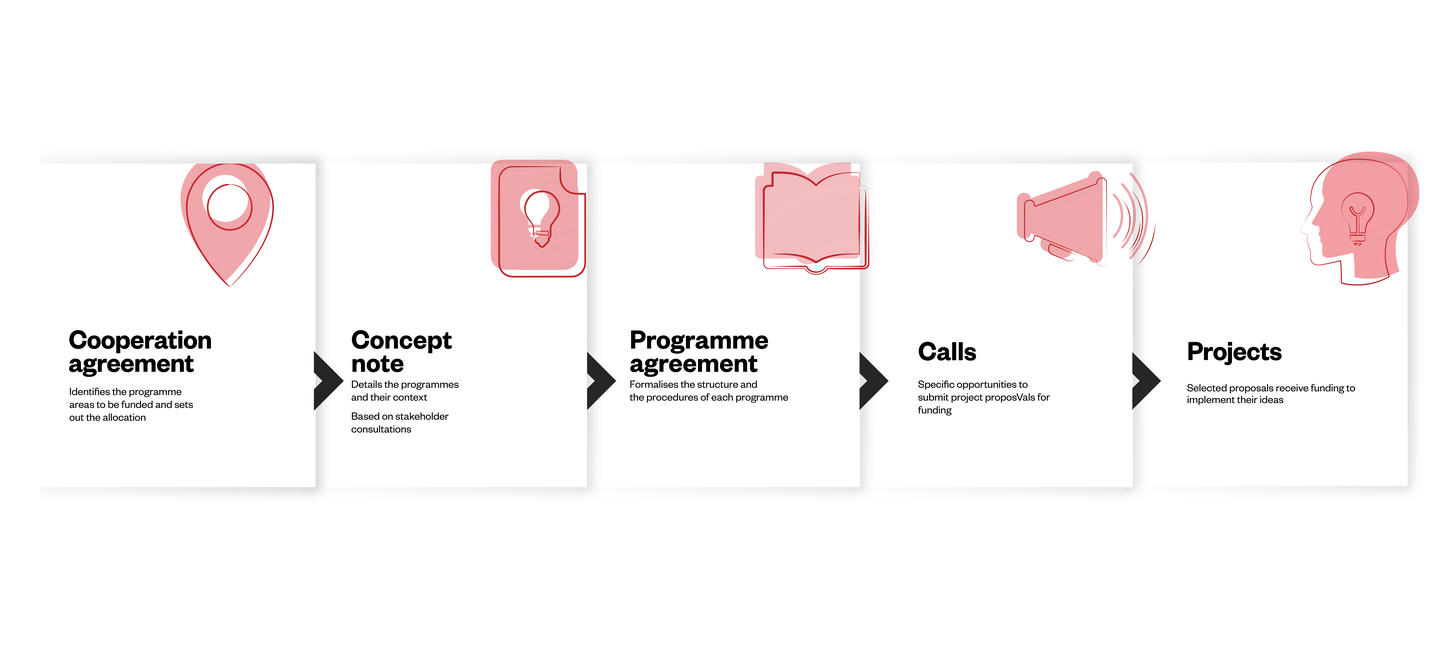Every programme has a clear objective – this means that all projects funded through a specific programme need to contribute to reaching the programme’s objective, and in doing so - the objectives of the EEA and Norway Grants. This makes the funding more strategic and focused. It also makes it easier to establish more strategic partnerships between Iceland, Liechtenstein and Norway, and the 15 beneficiary states.
Step 1: Setting the way forward
Iceland, Liechtenstein and Norway have entered into multi-year agreements with the European Commission on the EEA and Norway Grants. These agreements, dating back to 1994, include the total funding for the period, how that funding is allocated across the beneficiary countries and which topics can be funded.
Step 2: Ground for cooperation
The Cooperation agreement, or Memoranda of Understanding (MoUs) are framework agreements with each beneficiary State on how the funding will be implemented within that country in the given grant period. The agreement includes details on the country allocation, which programmes are to be funded, and the management set-up including information on cooperation with the donor countries. A separate agreement is signed for the EEA Grants and the Norway Grants.
In the 2014-2021 funding period, all 15 Beneficiary States have cooperation agreements in place.
Step 3 Defining the concepts
Consultations
People should always have a say on issues that affect them directly. That is why gathering opinions, concerns, suggestions and experiences – as early as possible – is key to making sure our programmes address the needs and challenges of all stakeholders involved. Since the beginning of the 2014-2021 funding period, we have held over 110 stakeholder consultations as the first step in the preparation of our programmes. In other words, we have consulted experts in areas ranging from the public and private sector to civil society and academia, across all the Beneficiary States. This has helped define some of the key issues in these fields, and suggest concrete solutions.
Concept notes
Following the consultations, we have prepared concept notes for each programme. The concept notes detail the programmes and their context, the societal challenges we address, the results we aim to achieve and how we plan to do so. This includes:
- defining objectives, target groups and the scope for partnerships with entities from the Donor States;
- selecting indicators and targets;
- outlining how many calls for project proposals will be launched.
Where relevant, the concept notes also include descriptions of pre-defined projects which will be funded through each programme. We have nearly completed this process, with 95 concept notes finalised by the end of 2019.
Step 4: Framing the work into programme agreements
Based on the Concept Note and the assessment of the Donor States, a Programme Agreement is prepared and signed between the Donor and Beneficiary States, setting out the terms and conditions of the operation of the programme, as well as the roles and responsibilities of all parties. This includes roles, budget, results framework, eligibility criteria and selection procedures, as well as payments and reporting. Once the agreements have been signed, we can launch the programmes and start funding projects.
Step 5: Supporting ideas for a green, competitive and inclusive Europe
We have now launched 1492 calls for proposals since the first calls were released in 2017. Out of these, 96 were launched in 2019. In addition to advertising these opportunities, we have held matchmaking events throughout the Beneficiary and Donor States to encourage and facilitate cooperation with partners from Iceland, Liechtenstein and Norway.
This has generally been done through cooperation between the institution responsible for the programme in the Beneficiary State, the Financial Mechanism Office (the secretariat of the EEA and Norway Grants) and partners in the Donor States or International Organisations.
